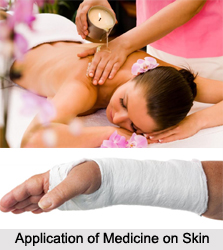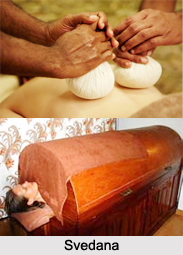 Applications of medicine to the skin, according to Sushruta consist of ghritas, oils, plasters, poultices, baths and hot applications for inducing perspiration. They are for the most part rubbed all over the body, except those intended for local ailments. In the Sushruta Samhita, Plasters called "Pralepa" are applied moist and cold, "Pradeha" or poultices are applied moist and hot. They are also thicker than plasters.
Applications of medicine to the skin, according to Sushruta consist of ghritas, oils, plasters, poultices, baths and hot applications for inducing perspiration. They are for the most part rubbed all over the body, except those intended for local ailments. In the Sushruta Samhita, Plasters called "Pralepa" are applied moist and cold, "Pradeha" or poultices are applied moist and hot. They are also thicker than plasters.
Another mode of application of medicine to the skin as mentioned by Sushruta is Svedana which means application of heat to the skin for inducing perspiration. This is carried out in 4 different ways, namely:-
1. Tapasveda: The application of dry heat by means of heated plates, bricks, sand, cloth or the palm of the hand only. These are recommended to be heated by catechu-wood fire.
2. Ushmasveda: The application of hot steam. This is affected in various ways. The part to be heated is covered with wet cloth. Bricks, stones or iron plates are made red hot and sprinkled over with Kanjika or some decoction, and are then applied to the part to be heated; or an earthen pot with a small opening in the side is filled with hot water or decoction of some drugs, a tube is adjusted to the hole in the pot and the steam is applied to the covered body through it. A third method consists in heating the ground by burning catechu-wood over it, and after removing the fire sprinkling some decoction over the spot and making a bed of castor oil leaves on it. The patient is to lie on this bed and cover himself with a blanket. Or the ground may be covered with a thick layer of boiled pulse such as mashakalaya and a bed made over it for the patient.
 3. Upandhasveda: This means the application of heat by hot medicinal substances in the form of decoctions, pastes, plasters, or of fomentation by cloth wrung out of hot fluids; or heat may be applied by enclosing hot medicinal substances or pastes within a cloth bag and applying the latter to the skin.
3. Upandhasveda: This means the application of heat by hot medicinal substances in the form of decoctions, pastes, plasters, or of fomentation by cloth wrung out of hot fluids; or heat may be applied by enclosing hot medicinal substances or pastes within a cloth bag and applying the latter to the skin.
4. Dravaaveda: This means the hot hip-bath and hot bath with warm water or decoctions. Milk, broth, oil, Kanjika etc., may also be used for baths. The patient should sit in a tub with the fluid up to his navel, and which should also be poured over his body, from above the shoulders, so as to bathe him thoroughly. The tub should be made of wood, silver, copper or iron, of square form and 26 fingers in measurement in all directions, that is in height, length and breadth. After the application of heat, the patient should take a hot bath, eat light food and keep himself covered in bed. If too much heat has been applied, and the patient suffers from pain in the joints, thirst, languor or giddiness, then he should be treated by cooling applications. The region of the heart, scrotum and eyes should be heated with great care and to a mild degree only.
Related Articles
Ayurveda
History of Ayurveda
Origin of Ayurveda
Ayurveda Medication
Principles Of Ayurveda
Elements of Ayurveda
Concepts of Ayurveda
Branches of Ayurveda
Ancient Literature of Ayurveda
Forms of Medicines in Ancient India




















